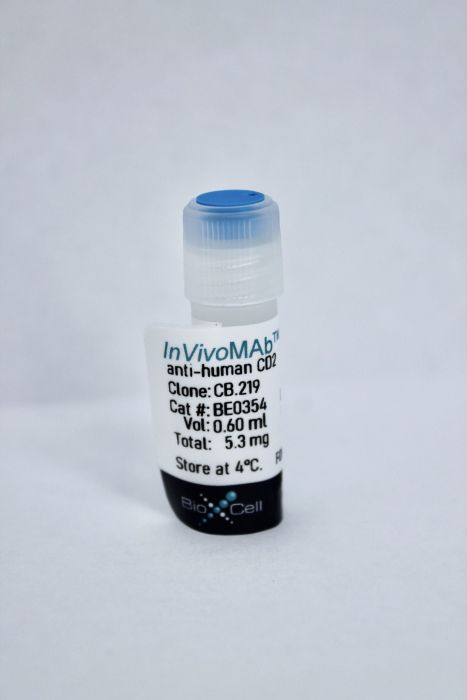InVivoMAb anti-human CD2
Product Details
The CB.219 monoclonal antibody reacts with human CD2, a 45-58 kD type I transmembrane glycoprotein, also known as LFA-2, T11 or Ly37. CD2 is a member of the Ig superfamily. CD2 is expressed by 80-90% of human peripheral blood lymphocytes, 95% of thymocytes, all T cells that form E-rosettes, and a subset of NK cells. CD2 functions as an adhesion receptor that binds to CD58 resulting in the activation of CD2-positive T cells and NK cells and in the regulation of their cytolytic activities. The CB.219 antibody interacts with the N-terminal CD58-binding region of CD2.Specifications
| Isotype | Mouse IgG2b, κ |
|---|---|
| Recommended Isotype Control(s) | InVivoMAb mouse IgG2b isotype control, unknown specificity |
| Recommended Dilution Buffer | InVivoPure pH 7.0 Dilution Buffer |
| Conjugation | This product is unconjugated. Conjugation is available via our Antibody Conjugation Services. |
| Immunogen | Human T4+ CTL clone |
| Reported Applications | in vivo CD2 blockade in huCD2tg mice |
| Formulation |
PBS, pH 7.0 Contains no stabilizers or preservatives |
| Endotoxin |
<2EU/mg (<0.002EU/μg) Determined by LAL gel clotting assay |
| Purity |
>95% Determined by SDS-PAGE |
| Sterility | 0.2 μM filtered |
| Production | Purified from cell culture supernatant in an animal-free facility |
| Purification | Protein A |
| RRID | AB_2894773 |
| Molecular Weight | 150 kDa |
| Storage | The antibody solution should be stored at the stock concentration at 4°C. Do not freeze. |
Recommended Products
in vivo CD2 blockade in huCD2tg mice
Erben, U., et al. (2015). "Preventive Anti-CD2 Treatment does not Impair Parasite Control in a Murine Toxoplasmosis Model" Eur J Microbiol Immunol (Bp) 5(4): 306-315. PubMed
Targeting human CD2 with the monoclonal antibody (mAb) CB.219 reduces intestinal inflammation in a colitis model where T cells carry human CD2. Here, we asked whether this mAb has adverse effects on infection control. Mice expressing human CD2 on T cells (huCD2tg) were orally infected with Toxoplasma (T.) gondii and treated with the human CD2-specific mAb CB.219 in a preventive setting. The intestinal T. gondii loads in CB.219 treated mice did not differ from the control group. Histologically, huCD2tg mice showed moderate ileal inflammation that did not change with CB.219 treatment. In the ileum, CB.219 treatment reduced the protein levels of interferon-gamma, transforming growth factor beta and interleukin-6, whereas interleukin-18 mRNA was slightly increased. The infiltration of neutrophils, macrophages, and T cells into the ileum was unaffected by CB.219 treatment. However, CB.219 treatment decreased the numbers of forkhead box P3(+) regulatory T cells (Treg) in ileum and liver of huCD2tg mice. This was confirmed in vitro using human peripheral blood mononuclear cells. Taken together, targeting CD2(+) T cells by the human CD2 mAb CB.219 does not prevent beneficial immune reactions necessary for pathogen control. Further experiments will address gut specificity, underlying mechanisms, and general applicability of CB.219 treatment.
in vivo CD2 blockade in huCD2tg mice
Erben, U., et al. (2015). "Targeting human CD2 by the monoclonal antibody CB.219 reduces intestinal inflammation in a humanized transfer colitis model" Clin Immunol 157(1): 16-25. PubMed
The cell adhesion molecule CD2 facilitates antigen-independent T-cell activation and CD2 deficiency or blockade reduces intestinal inflammation in murine models. We here aimed to evaluate the therapeutic potential of monoclonal antibodies (mAb) specific for human CD2 in colitis treatment. Transfer colitis induced by naive CD4(+) T cells expressing human CD2 was treated with anti-human CD2 mAb. The mAb CB.219 protected from severe colitis in a preventive treatment regimen, while therapeutic treatment ameliorated intestinal inflammation. Diminished intestinal tissue damage was paralleled by a profound suppression of lamina propria lymphocytes to produce pro-inflammatory cytokines and tumor necrosis factor alpha as well as the neutrophil chemoattractant CXC motif ligand 1 and the CC chemokine ligand 3. Furthermore, infiltration with macrophages and T cells was low. Thus, reduced intestinal inflammation in our humanized colitis model by targeting CD2 on T cells with the mAb CB.219 suggests a novel approach for colitis treatment.



